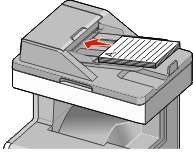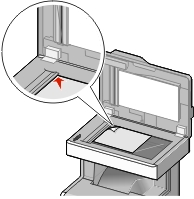Scanning to a computer or flash drive
| |
Use the ADF for multiple-page documents. | Use the scanner glass for single-page documents, small items (such as postcards or photos), transparencies, photo paper, or thin media (such as magazine clippings). |
The scanner lets you scan documents directly to a computer or a flash drive. The computer does not have to be directly connected to the printer for you to receive Scan-to-PC images. You can scan the document back to the computer over the network by creating a scan profile from the computer and then downloading the profile to the printer.
Scanning to a computer
Type the printer IP address into the address field of your Web browser.
If you do not know the IP address of the printer, you can:
View the IP address on the printer control panel in the TCP/IP section under the Networks/Ports menu.
Print a network setup page or the menu settings pages and locate the IP address in the TCP/IP section.
Click Scan Profile > Create.
Select your scan settings, and then click Next.
Select a location on your computer where you want to save the scanned output file.
Enter a scan name.
The scan name is the name that appears in the Scan Profile list on the display.
Click Submit.
Review the instructions on the Scan Profile screen.
A shortcut number was automatically assigned when you clicked Submit. You can use this shortcut number when you are ready to scan your documents.
Load an original document faceup, short edge first into the ADF or facedown on the scanner glass.
| Note: Do not load postcards, photos, small items, transparencies, photo paper, or thin media (such as magazine clippings) into the ADF. Place these items on the scanner glass. |
If you are loading a document into the ADF, then adjust the paper guides.
Press  , and then enter the shortcut number using the keypad, or touch Held Jobs on the home screen, and then touch Profiles.
, and then enter the shortcut number using the keypad, or touch Held Jobs on the home screen, and then touch Profiles.
After entering the shortcut number, the scanner scans and sends the document to the directory or program you specified. If you touched Profiles on the home screen, then locate your shortcut on the list.
Return to the computer to view the file.
The output file is saved in the location or launched in the program you specified.
Scanning to a flash drive
Load an original document faceup, short edge first into the ADF or facedown on the scanner glass.
| Note: Do not load postcards, photos, small items, transparencies, photo paper, or thin media (such as magazine clippings) into the ADF. Place these items on the scanner glass. |
If you are loading a document into the ADF, then adjust the paper guides.
Insert the flash drive into the USB port on the front of the printer.
The USB Drive home screen appears.
Select the destination folder, and then touch Scan to USB drive.
Adjust the scan settings.
Touch Scan It.
Using the ScanBack Utility
You can use the Lexmark ScanBackTM Utility instead of the Embedded Web Server to create scan-to-PC profiles. The ScanBack Utility can be downloaded from the Lexmark Web site home page on http:\\support.lexmark.com.
Set up your scan-to-PC profile:
Launch the ScanBack Utility.
Select the printer.
If no printers are listed, then contact your system support person, or click Setup to manually search for an IP address or host name.
Follow the instructions on your computer screen to define the type of document being scanned and what kind of output you want to create.
Select any of the following:
Click Finish.
A dialog box appears with your scan profile information and the status of the received images.
Scan your original documents:
Load all pages in the ADF or on the scanner glass.
From the printer control panel, navigate to:
Scan/Email > Profiles > select your scan profile > Submit
| Note: Your output file is saved in a directory or launched in the application you specified. |
Using the scan profile options
Original Size
This option sets the size of the documents you are going to scan. When Original Size is set to Mixed Sizes, you can scan an original document that contains mixed paper sizes (letter- and legal-size pages).
Resolution
This option adjusts the output quality of your file. Increasing the image resolution increases the file size and the time needed to scan your original document. Image resolution can be decreased to reduce the file size.
Color
This option enables or disables color for the scanned image.
Content
This option lets you specify the content type and source of the original document.
Choose content type from Text, Text/Photo, Photo, or Graphics.
Text—Use when the content of the original document is mostly text or line art.
Graphics—Use when the original document is mostly business-type graphics such as pie charts, bar charts, and animations.
Text/Photo—Use when the original document is a mixture of text, graphics, and photos.
Photo—Use when the original document is mostly a photo or an image.
Choose content source from Color Laser, Black/White Laser, Inkjet, Photo/Film, Magazine, Newspaper, Press, or Other.
Color Laser—Use when the original document was printed using a color laser printer.
Black/White Laser—Use when the original document was printed using a mono laser printer.
Inkjet—Use when the original document was printed using an inkjet printer.
Photo/Film—Use when the original document is a photo from film.
Magazine—Use when the original document is from a magazine.
Newspaper—Use when the original document is from a newspaper.
Press—Use when the original document was printed using a printing press.
Other—Use when the original document was printed using an alternate or unknown printer.
Darkness
This option adjusts how light or dark your scanned documents will turn out in relation to the original document.
Page Setup
This option lets you change the Sides (Duplex), Orientation, and Binding.
Sides (Duplex)— Use this to specify if the original document is simplex (printed on one page) or duplex (printed on both sides). This also identifies what needs to be scanned for inclusion in the e-mail.
Orientation— Use this to specify the orientation of the original document, and then change Sides and Binding to match the orientation.
Binding— Use this to specify if the original document is bound on the long-edge or short-edge of the page.
Scan Preview
This option displays the first page of the image before it is included in the e-mail. When the first page is scanned, the scanning is paused and a preview image appears.
Advanced Options
Touching the Advanced Options button opens a screen where you can change the following settings:
Advanced Imaging—Use to change or adjust Background Removal, Color Balance, Color Dropout, Contrast, JPEG Quality, Mirror Image, Negative Image, Scan Edge to Edge, Shadow Detail, Sharpness, and Temperature settings before scanning a document.
Custom Job—Use to combine multiple scan jobs into a single scan job.
Edge Erase—Use to remove smudges or information around the edges of a document. You can choose to eliminate an equal area around all four sides of the paper, or pick a particular edge. Edge Erase will erase whatever is within the area selected, leaving nothing on that portion of the scanned image.
Transmission Log—Use to print the transmission log or transmission error log.


 , and then enter the shortcut number using the keypad, or touch Held Jobs on the home screen, and then touch Profiles.
, and then enter the shortcut number using the keypad, or touch Held Jobs on the home screen, and then touch Profiles.